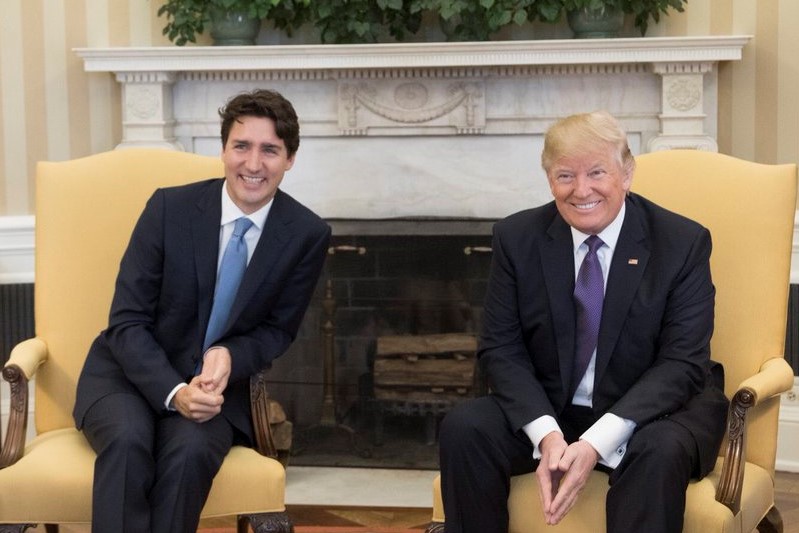The trade deal signed by Canada with the U.S. on Sunday night is called the United States-Mexico-Canada Agreement (USMCA).
If approved by the U.S. Congress, it will replace NAFTA.
The late Mel Hurtig, a foremost publisher, authored his first book about the 1988 Canada-U.S. Free Trade Agreement (FTA), the trade deal that NAFTA replaced. The Betrayal of Canada was a number 1 bestseller.
The USMCA deal awaits a sequel: The Further Betrayal of Canada.
The outrageous 25 per cent U.S. steel and 10 per cent U.S. aluminium tariffs remain in place, choking Canadian industry. Maybe that is why there is no pretext this time of pretending that a continental economic integration project cooked up in Washington for its benefit should be called a “free trade” agreement.
The U.S. tariffs were applied to protect national security. Canada is a NORAD security partner with the U.S. in joint continental defence and a NATO security partner of the U.S. as well. Despite being inside the joint security perimeter, Canada did not get exempted from the application of these Section 232 national security tariffs. Worse, whenever the U.S. decides to play the national security card, it can do it again. Why sign a trade deal with a country that makes up bogus excuses to move jobs from your country to their country?
On automotive trade Canada was promised a reasonable quota for future exports. Good. But that still leaves other sectors open to U.S. bullying.
In Article 32.10 Canada agreed not to negotiate commercial agreements with non-market countries. That would be China. Should Canada decide to sign a trade agreement with China, the non-market country, it would be booted out of USMCA. For trade expert Peter Clark this amounts to Canada being treated as a vassal state by the U.S.
In the original FTA talks, chief U.S. negotiator Peter Murphy had a handwritten list of issues he wanted discussed that got into the hands of the media. The list included scrutinizing currency rates. Canada resisted.
In the new deal, Chapter 33 is entitled “Macroeconomic Policies and Exchange Rate Matters.” From now on Canada gets to sit down with the U.S. whenever they think our dollar is too low and admit to currency manipulation. So much for central bank independence. Macroeconomic policy — that would be government spending and taxation — is something Canada now has to co-ordinate with the U.S. as well.
The key instruments of Canadian economic development have been federal Crown corporations. Under this deal in Chapter 22 they become State-Owned Enterprises and their activities are restricted to non-competition with private sector companies. So forget creating a public sector company to build transit vehicles and employ autoworkers. The USMCA text spells out the penalties to be paid for non-compliance — in other words, for pursuing the public interest as defined by the federal Parliament.
Remember the 2008 collapse of Wall Street and the multi-trillion-dollar bailouts of U.S. banks … but not of clients with mortgages?
Under Chapter 17, the USMCA allows U.S. financial institutions to set up in Canada without receiving “lender of last resort” support from Canada. Who then is going to do the bailouts when the unsupervised U.S. banks go bust again? Under the Basel Accords on banking practices, the U.S. Federal Reserve has to step up in the event of solvency crises, but the host country, Canada, would look after a liquidity crisis.
The false claim of “Canadian cultural exemption” is back. That would be the provision where Canada asserts its right to make investments in cultural industries … and where the U.S. gets to retaliate in kind against any sector it chooses to single out (Article 32.6: 4) if Canada does provide cultural subsidies! Little wonder the federal government has been so reluctant to make any investments in culture.
Canada granted further concessions to U.S. demands on intellectual property rights, which are monopoly rights. Goodbye, Trudeau-promised pharmacare.
In a startling surrender to the extraterritorial application of U.S. law, under Annex 3-B the Liberals will allow Americans to interfere in milk pricing. Trudeau waited until the day before the Quebec election to admit the dairy sector was going to be subject to U.S. demands. The federal government will have to deal with the fallout once the next Quebec government finds out what a Liberal promise to protect dairy farmers amounted to.
Team Trudeau needed a deal because the Business Council of Canada wanted a deal. President John Manley had earlier confided to the Financial Post that anyone who thought Canada was not going to get a worse deal from Trump that it had under NAFTA was delusional. He was previewing what he would accept.
To pre-empt an attack from Conservatives, prominent former ministers James Moore and Rona Ambrose were advisers on the deal. In an attempt to mute the NDP, former party president Brian Topp was invited to take part as well.
The USMCA is being spun in Canada as a tweak to NAFTA. By the time the U.S. implementing legislation gets written up, even the trade policy specialists usually onside are going to be critical of much that is new.
So far not one new positive element has been identified in the USMCA as a benefit for Canada.
Pierre Trudeau called the original FTA with the U.S. “a monstrous swindle.” The new deal is that, plus a set of unnecessary capitulations to shut up Donald Trump on trade. It won’t.
Duncan Cameron is president emeritus of rabble.ca and writes a weekly column on politics and current affairs.
Photo: @WhiteHouse on Twitter/Wikimedia Commons
Help make rabble sustainable. Please consider supporting our work with a monthly donation. Support rabble.ca today for as little as $1 per month!




